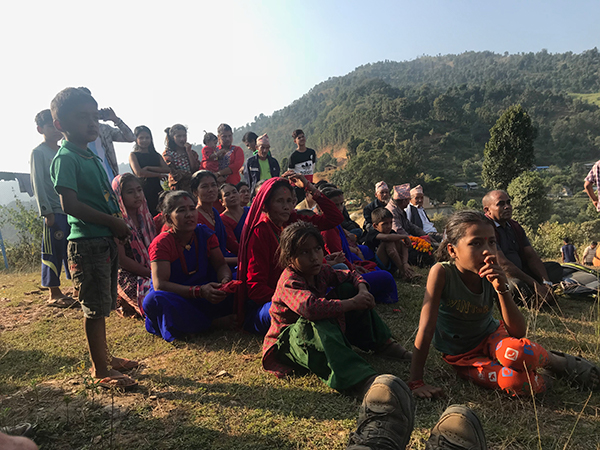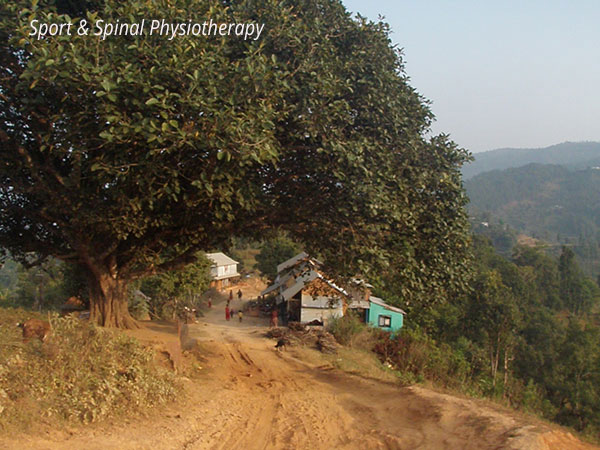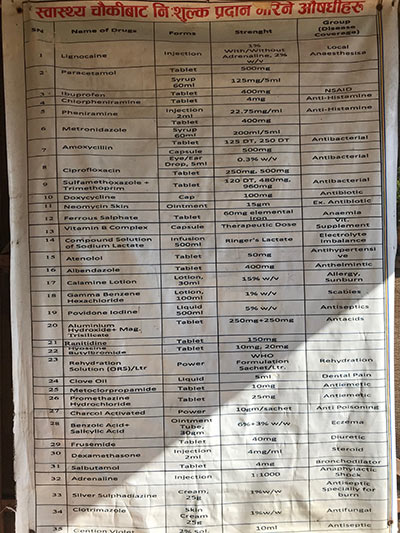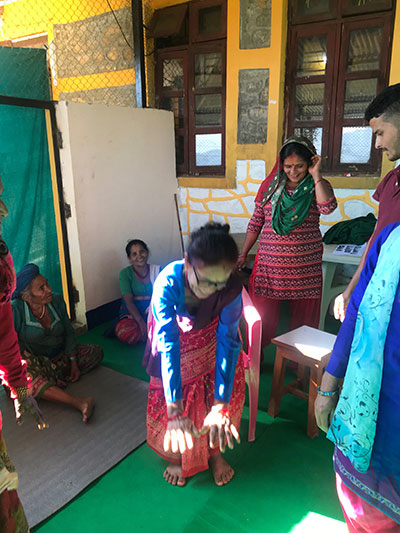Charitable works: My Experience as a Physiotherapist Volunteer in Nepal
In October 2018, as part of the Charitable Work program at Sport & Spinal Physiotherapy, I was sent as a Physiotherapist to volunteer in Nepal. I travelled to Nepal to volunteer in a very remote village, Maidi. Maidi is 4 hours out of Kathmandu. Mind you, 1 of these 4 hours was spent driving a mere 8km down a beaten track full of potholes, rocks and animals; hence “remote village”.
Earlier in 2018, Craig also travelled to begin what we hope to become regular volunteering trips for staff at Sport & Spinal Physiotherapy. You can check out his articles here and here.
Unfortunately, my week of volunteering was reduced to two and a half days and my intended plans were thrown out the window. I was unable to make it to the village on time for a few reasons; 1) I missed my connecting flight in Hong Kong. 2) ‘Nepali Time’ (no one is in a rush to do anything). And 3) There was an unfortunate and an untimely death with a member of the Village. Nepali customs allow for 13 days of mourning so they would not respond well to an outsider coming in.
Getting to Maidi Village
Despite this, I eventually made it to Maidi village. On arrival, the locals welcomed us in a Welcoming Ceremony which is custom for all visitors and the gratitude for previous and future physiotherapy was expressed. Despite having very little and living in an extreme third world country the Nepalese are always happy.
They are grateful for every little thing and just happy to be surrounded by their friends and family. They don’t need materialistic items or the newest gadgets yet are so content with life. A lesson I’m trying to learn and a lesson many of us could do with learning!
Unfortunately, this also flows into their health care system – contentment with lack of services available and an attitude of soldiering on without concern for their health.
The first Question: “Have you got any pills?”
After the hour-long ceremony had finished late in the afternoon I was immediately surrounded by possible clients. I was surrounded because they wanted medications. My very first questions “do you have pills?”.
When I made it clear I had none, my client list almost halved! Sadly in this village the doctors prescribe drugs far too often without addressing the underlying cause of pain.
One lady had been told that she had spinal degeneration and arthritis and there was nothing that could be done for her besides drugs. She was 37 years old and otherwise healthy but had developed extreme fear around her pain.
She now showed global pain from her lower back to upper traps and had become very guarded with all her movements. I showed her some simple stretches and encouraged the few people surrounding to join in. Before I realised, there were 15+ villagers touching their toes and stretching their neck.
I tried to use a translator to educate her on looking after her spine, that degeneration was common and there was plenty that can be done for it. How much she took in or believed, I don’t know.
Challenge #1: Misconceptions Around Pain and The Over-Prescription of Pills
This village does not have easy access to any health professionals other than a local ‘doctor’ whose qualifications I wasn’t able to work out. And four female nurses – who have no qualifications but enjoy helping people.
Unfortunately the current method for pain complaints whether it’s a broken bone, a soft tissue injury or back pain is pills and medications. What I call a ‘band-aid fix’. In majority of cases this takes away pain temporarily, the pain then returns and the person is placed on another round of pain killers.
A vicious cycle that ultimately leads to increased pain and decreased function.
Treating The Villagers
The day started slowly with a steady flow of men coming in for mainly treatment of lower back and knee pain. However, within 1 hour, word had certainly spread with a line-up of 20+ villagers waiting for their turn. When I say line-up I really mean a congregation of people in a small room while I was treating – giving no privacy at all.
Eventually the room was so full and the line was backed up, that I had no option but to revert to recipe style treatment – organising into groups of injuries and prescribing all the same exercises. I was able to separate into lower back, knees and neck. However 75% of the clients stayed for 2 out of the 3 categories. This was very basic physiotherapy and is very different from what I do in Australia, yet the results were sometimes instantaneous. On top of this, every person that came in was beyond appreciative and thankful for the small amount of help that I had shared.
It was reiterated over and over that completing these exercises every day for the rest of their lives was the best way to healing. Drugs aren’t the answer. Passive treatment is not the answer.
I treated from 9:00am to 6:00pm and had over 65 villagers come in and out of the Outpost on Day 1. Then I repeated the following morning, treating from 9:30am to 2:00pm and seeing another 35 villagers. I felt a huge sense of achievement, yet it was dulled knowing my 2 days really projected to very little on the large scale.
 Challenge # 2: Lower Back and Knee Pain
Challenge # 2: Lower Back and Knee Pain
By far the most common complaint was lower back pain and knee pain. Which makes entire sense once understanding how the village works. They survive on harvesting rice in the fields. This involves long periods of:
- Bending over slashing the rice
- Carrying the harvested rice with buckets strapped around their heads.
- Walking up and down steep hills with this bucket on their head.
- Bending over sorting the rice.
- Bending over or in a deep squat position replanting the rice seeds.
Day in, day out. The members of this village are some of the hardest working people I have come across, and they don’t know how to look after their bodies outside of this.
Challenge #3: Ratio of Men:Women
Of the villagers I treated, roughly 90% were male and 90% were over the age of 50. In Nepal there still stands a massive hierarchy system. Men are considered far more important and age trumps youth.
I disagree with this system but it isn’t an obstacle that I could change. Nepal is a country very set in their customs and ways. Changes will be very small, very progressive and very slow.
In Craig’s previous post, you may have read that the women stay at home doing the ‘domestic’ duties. This is not comparable to western household duties. These women leave the house before sunrise each morning to work in the fields. They will spend hours upon hours harvesting, carrying 20kg+ on their head while also maintaining the children, the home and the extended family (including the in-laws). Without the women in this village the men, children and elderly would simply not survive. This lifestyle leads to my next point: women’s health issues.
Interesting Cases
There were a few interesting cases that stood out to me.
Cervical Spine Impingement
One to note was of a man who complained of a 2-3 week history of radiating pain down his right arm. He assured me that he had no neck pain but displayed very limited neck range. His right arm pain was also increased with right rotation (turning his head to the right). To me it looked very clear that it was cervical impingement with radiculopathy. Some people may refer to it as “a pinched nerve”.
For this man I did use hands-on treatment. Some simple soft tissue release and cervical spine mobilisation. He was surprised when I could reproduce his pain with my hands. But was pleasantly surprised when his pain had significantly decreased after 5 minutes of treatment. This man was so grateful he then brought his family to give me well wishes.
Prolapse?
I also had a particular lady (one of very few) who came to the outpost. She was very timid and reserved. I could tell when explaining her ‘injury’ to Amritt, the translator, that she was extremely embarrassed. Of course she would be – she was surrounded by men watching her get treated. Amritt tried to explain that she had ‘tummy’ problems. I tried to ask a few more questions but she quickly changed her story to resort to lower back pain.
I also tried to teach her some simple core activities but she was not able to complete these. Wearing a skirt, as women in Maidi do, she could not lift her legs or she would obviously be exposing herself to the surrounding men.
An opportunity I feel I lost in helping just one woman who I believe was suffering either from incontinence or uterine prolapse. In my following article I will talk more about this, as well as I what I hope to change in the future.
Challenge #4: Women’s Health Issues
Women are expected to work the day after giving birth because their role is so important. This culture has lead to Nepal having the highest rate of uterine prolapse and incontinence in the World! Once a woman develops prolapse she is then rejected from her family.
She is considered useless for her children, her husband and the village. She is then forced out by her mother-in-law to become a beggar. Being female, I obviously wanted to have an impact here, the only problem being I’d already lost 2 and a half days of village time!
Read Part 2 of my volunteering experience in Nepal here




